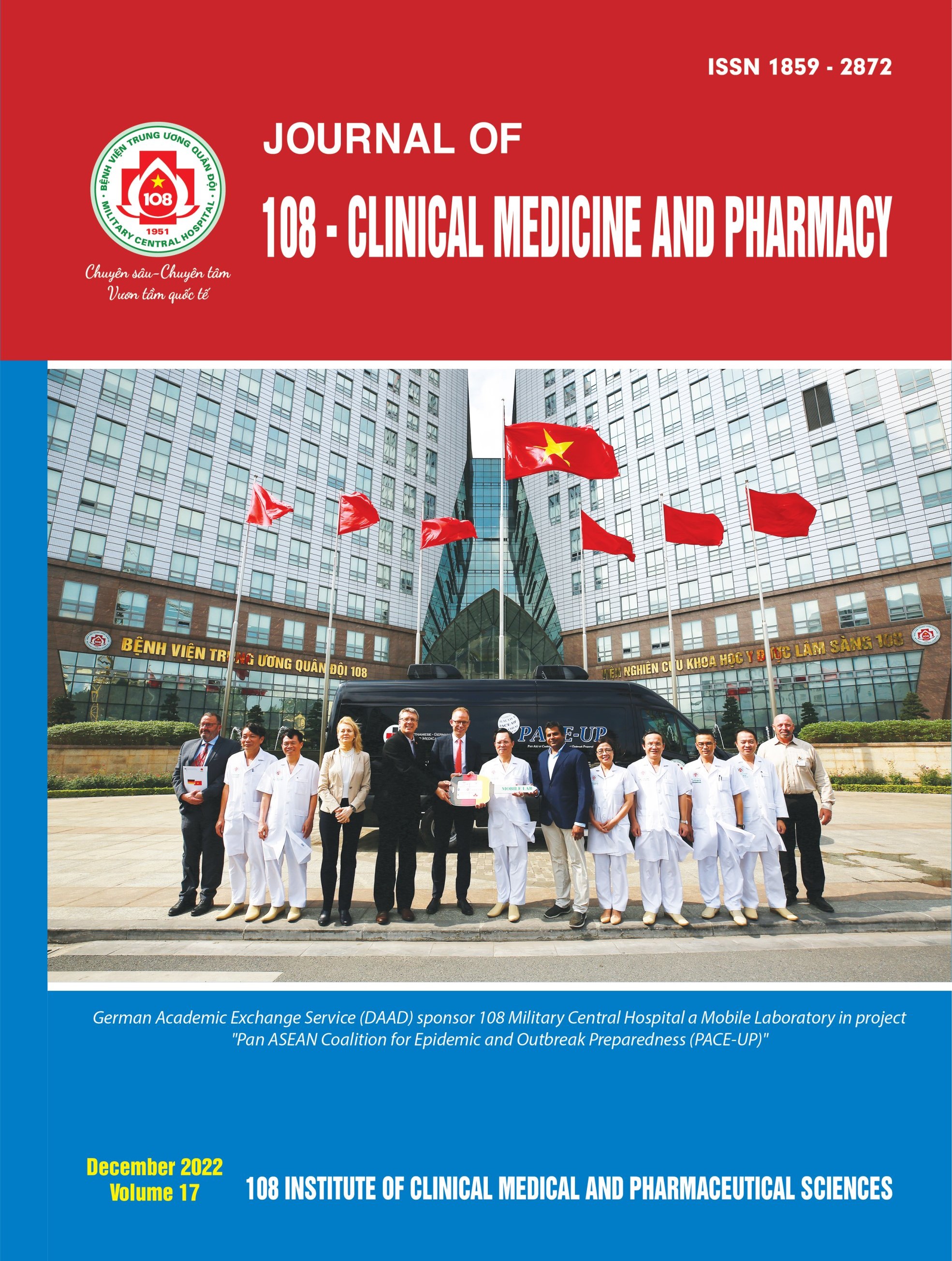Safety and efficacy of internal carotid artery infusion of autologous bone marrow-derived stem cells in subacute middle cerebral artery infarct
Main Article Content
Tóm tắt
Objective: To evaluate the safety and the efficacy of internal carotid artery (ICA) infusion of autologous bone marrow-derived stem cells (BMSC) in subacute middle cerebral artery (MCA) infarct. Subject and method: A prospective, open-label, non-randomized was conducted in patients with MCA infarct, within 7-40 days from onset. Sixty-two patients satisfying the inclusion criteria were enrolled and allocated into either BMSC group (n = 31) or control group (n = 31). Follow-ups were performed at 6 months and 1 year after therapy. Adverse events were noted to conclude safety outcome. The primary efficacy outcomes were percentages of recovered patients with a score of 0 to 2 on the modified Rankin Scale (mRS). The secondary efficacy outcomes were evaluated by the National Institutes of Health Stroke Scale (NIHSS), Barthel Index (BI), Brunnstrom stages of hand (BRS-H), and infarct volume on head MRI. Result: There were no significant differences in the percentages of noted adverse events. The percentages of the mRS 0-2 in BMSC group were remarkably higher as compared to control group at both 6-month and 1-year follow-up, but not statistically significant (25.8% vs 6.9%, p=0.08 and 26.7 vs 9.7, p=0.1, respectively). BI at 6 months was significantly better in the BMSC group, however no significant differences on other secondary efficacy measures. Conclusion: ICA infusion of BMSC was safe and tolerated in patients with subacute MCA infarct. Although the difference in the primary efficacy outcomes was not statistically significant, a favorable trend was found in BMSC group representing by the BI at 6 months and the percentages of mRS 0-2 at both main follow-ups.
Article Details
Các tài liệu tham khảo
2. Li L, Jiang Q, Ding G, Zhang L, Zhang ZG, Li Q, Panda S, Lu M, Ewing JR, Chopp M (2010) Effects of administration route on migration and distribution of neural progenitor cells transplanted into rats with focal cerebral ischemia, an MRI study. J Cereb Blood Flow Metab 30(3): 653-662.
3. Bhatia V, Gupta V, Khurana D, Sharma RR, Khandelwal N (2018) Randomized assessment of the safety and efficacy of intra-arterial infusion of autologous stem cells in subacute ischemic stroke. AJNR Am J Neuroradiol 39(5): 899-904.
4. Moniche F, Gonzalez A, Gonzalez-Marcos JR, Carmona M, Piñero P, Espigado I, Garcia-Solis D, Cayuela A, Montaner J, Boada C, Rosell A, Jimenez MD, Mayol A, Gil-Peralta A (2012) Intra-arterial bone marrow mononuclear cells in ischemic stroke: A pilot clinical trial. Stroke 43(8): 2242-2244.
5. Savitz SI, Yavagal D, Rappard G, Likosky W, Rutledge N, Graffagnino C, Alderazi Y, Elder JA, Chen PR, Budzik RF Jr, Tarrel R, Huang DY, Hinson JM Jr (2019) A phase 2 randomized, sham-controlled trial of internal carotid artery infusion of autologous bone marrow-derived ALD-401 cells in patients with recent stable ischemic stroke (RECOVER-Stroke). Circulation 139(2): 192-205.
6. Brott T, Adams HP Jr, Olinger CP, Marler JR, Barsan WG, Biller J, Spilker J, Holleran R, Eberle R, Hertzberg V, et al (1989) Measurements of acute cerebral infarction: A clinical examination scale. Stroke 20(7): 864-870.
7. Mahoney FI and Barthel DW (1965) Functional evaluation: The barthel index. Md State Med J 14: 61-65.
8. Bruno A, Akinwuntan AE, Lin C, Close B, Davis K, Baute V, Aryal T, Brooks D, Hess DC, Switzer JA, Nichols FT (2011) Simplified modified rankin scale questionnaire: Reproducibility over the telephone and validation with quality of life. Stroke 42(8): 2276-2279.
9. Saver JL, Chaisinanunkul N, Campbell BCV, Grotta JC, Hill MD, Khatri P, Landen J, Lansberg MG, Venkatasubramanian C, Albers GW (2021) Standardized nomenclature for modified rankin scale global disability outcomes: Consensus recommendations from stroke therapy academic industry roundtable XI. Stroke 52(9): 3054-3062.
10. Pandian S, Arya KN, and Davidson EWR (2012) Comparison of Brunnstrom movement therapy and motor relearning program in rehabilitation of post-stroke hemiparetic hand: A randomized trial. Journal of Bodywork and Movement Therapies 16(3): 330-337.
11. Sims JR, Gharai LR, Schaefer PW, Vangel M, Rosenthal ES, Lev MH, Schwamm LH (2009) ABC/2 for rapid clinical estimate of infarct, perfusion, and mismatch volumes. Neurology 72(24): 2104-2110.
12. Albers GW, Marks MP, Kemp S et al (2018) Thrombectomy for stroke at 6 to 16 hours with selection by perfusion imaging. N Engl J Med 378(8): 708-718.
13. Jovin TG, Chamorro A, Cobo E et al (2015) Thrombectomy within 8 hours after symptom onset in ischemic stroke. N Engl J Med 372(24): 2296-2306.
14. Heinsius T, Bogousslavsky J, and Van Melle G (1998) Large infarcts in the middle cerebral artery territory. Etiology and outcome patterns. Neurology 50(2): 341-350.
15. Rothrock JF, Clark WM, and Lyden PD, Spontaneous early improvement following ischemic. Stroke 26(8): 1358-1360.
16. Walcott BP, Miller JC, Kwon CS, Sheth SA, Hiller M, Cronin CA, Schwamm LH, Simard JM, Kahle KT, Kimberly WT, Sheth KN (2014) Outcomes in severe middle cerebral artery ischemic stroke. Neurocrit Care 21(1): 20-26.
17. Fischer UM, Harting MT, Jimenez F, Monzon-Posadas WO, Xue H, Savitz SI, Laine GA, Cox CS Jr (2009) Pulmonary passag
 ISSN: 1859 - 2872
ISSN: 1859 - 2872
